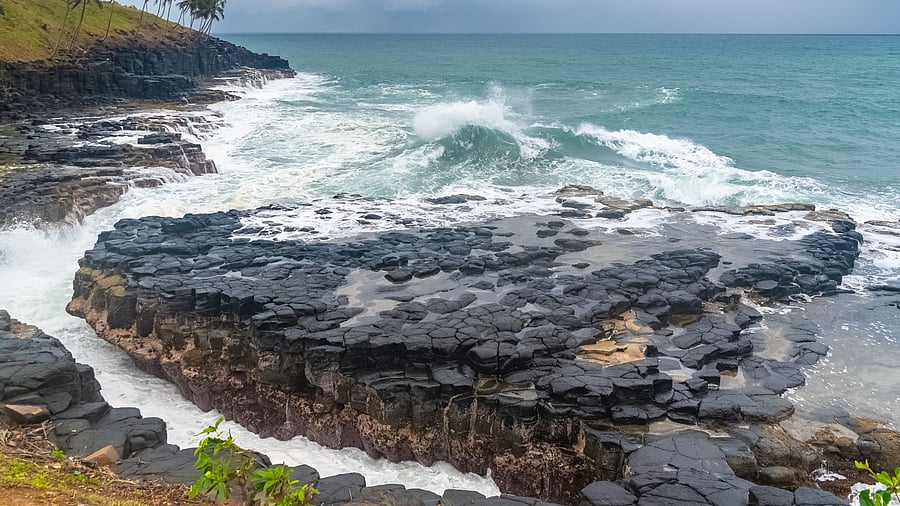
São Tomé.
Credit: iStock Photo
São Tomé and Príncipe, which straddle the Equator off the coast of Gulf of Guinea, constitute Africa’s second-smallest country (after Seychelles). There is nothing cosmetic about these stunning twin islands. They were uninhabited until the Portuguese discovered them in 1485. They wanted to cultivate sugarcane because of which São Tomé became an outpost of the slave trade. Jewish children from the Iberian Peninsula and people from Angola, Mozambique, Cape Verde and Congo became the main sources of plantation workers.
These lush islands possess several stunning natural features that rival some of the best in the world. The pristine sandy beaches, dreamy waterfalls, lush rainforests, unique biodiversity, stupendous volcanic peaks, gushing streams, medicinal gardens, fruit farms, vantage viewpoints overlooking dense jungles and historical plantation sites, have all earned these islands many epithets from visitors and tourists alike.
Landing in São Tomé is like setting foot into some nature documentary. The coastal drive from the airport is skirted by quaint fishing villages, glorious beaches hugged by palm trees, and luscious landscapes.
The outskirts of the city are dressed up in green blankets of banana and cocoa plantations. Cashew and pomegranate trees grow nonchalantly across the city.
Where São Tomé and Príncipe are peerless (alongside Galapagos Islands) is in their incredible biodiversity and the range of endemic species of fauna and flora they hold. The Obo Natural Park occupies a very special place not just in São Tomé, but in the entire African continent.
The archipelago contains the richest diversity of flora, with very high rates of endemism. It is the second most important in terms of biological interest among 75 forests in Africa. Not visiting the Obo Natural Park, is like skipping the Taj Mahal when touring Agra or missing out on Disneyland when visiting Orlando.
São Tomé and Príncipe is one of the few places in the world where the equator passes through. The historical plantation estates of São Tomé and Príncipe are a world by itself. It is a culturally diverse country. The performing arts of São Tomé are mystical and symbolise the synthesis of African and European traditions and the coexistence of two different cultures.
Though stratified by ethnic groups and social status, São Toméans are largely united in their way of life. São Tomé and Príncipe’s constitution provides for freedom of religion. The population is predominantly Christian (80% Catholics and 15% Protestants). São Toméans trace their ancestry to Africa and Portugal.
Portuguese is the main spoken language.
Daily life in São Tomé is really ‘leve leve’, meaning ‘take it easy’. It does take some adjusting for most of us who are used to the hustle and bustle of modern city life and the pressure of today’s work culture.
There is no such thing as a traffic jam in the city. During the so-called peak hours, the main thoroughfare has only a handful of cars and motorbikes. With no traffic lights, one can get by seamlessly and quickly without using the horn.
The unsullied natural beauty of São Tomé and Príncipe is matched by an equally charming colonial landscape. Though São Tomé became independent in 1975, it retains much of the 16th-century colonial architecture. As one ambles into the city centre, one is charmed by the tropical simplicity of this African city. More captivating are the faded yet alluring splendour of old colonial buildings, with carved wooden wraparound balconies, arched windows, and balustrades — many of which have been restored in bright vibrant colours. The city centre is the only place where there is a mild buzz. Teenagers sporting caps and nicely suited white-collar workers mingle together. Healthy-looking and chirpy school children with braided hair can be seen buying stuff from street vendors and mothers with babies slung behind their backs walking with unhurried languid ease. Bright yellow taxis jostle for space with motorbikes and shabby-looking jeeps. Moneychangers and telephone card sellers squat on street corners, while shoppers haggle with a variety of street vendors. It is common to see women selling huge tuna fish in cane baskets.
The city has several tiny shops and galleries that display exquisite traditional wood carvings, mask-making, jewellery from seashells, paintings and traditional ornaments. Though São Tomé depends heavily on external aid, it displays high social indicators. At 71 years, São Tomé’s life expectancy is higher than that of its neighbours. There is an equal gender ratio in its population. The literacy rate is 83%, while 65% of its population has access to improved water sources.
The economy of São Tomé is heavily dependent on agricultural exports and tourism. Despite its undeniable appeal as a tourist destination, São Tomé and Príncipe remains one of the world’s least-visited countries. This can be attributed to its remote location, lack of connectivity and visibility. But if one is looking to balance their vital health indicators, São Tomé is the place to be.
(The author is former Ambassador of India to the Republic of São Tomé and Príncipe.)